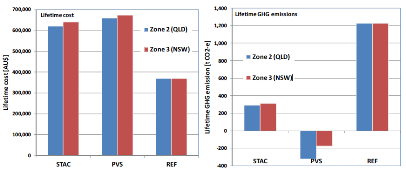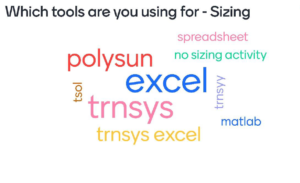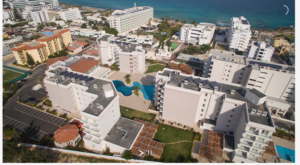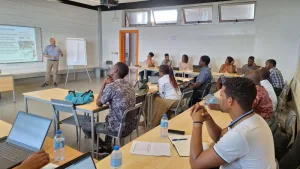

Lifetime Costs
Australia: Economics of Solar Thermal, PV-based and Conventional Cooling System (2010)
 In Australia, solar cooling is still a niche technology – despite good solar resources and a large air-conditioning and refrigeration market. The multiple market barriers which prevent the technology from achieving greater market shares are mostly economic in nature. During a presentation at the 9th IIR Gustav Lorentzen Conference 2010 in Sydney, Dr Paul Kohlenbach, Director of international solar cooling consultancy Solem Consulting, and Dr Mike Dennis of the Australian National University, highlighted these market barriers and opportunities for solar cooling in Australia. Kohlenbach himself has additionally carried out a study comparing the economics of a solar thermal, a PV-based and a conventional cooling system over a 20-year lifespan.
In Australia, solar cooling is still a niche technology – despite good solar resources and a large air-conditioning and refrigeration market. The multiple market barriers which prevent the technology from achieving greater market shares are mostly economic in nature. During a presentation at the 9th IIR Gustav Lorentzen Conference 2010 in Sydney, Dr Paul Kohlenbach, Director of international solar cooling consultancy Solem Consulting, and Dr Mike Dennis of the Australian National University, highlighted these market barriers and opportunities for solar cooling in Australia. Kohlenbach himself has additionally carried out a study comparing the economics of a solar thermal, a PV-based and a conventional cooling system over a 20-year lifespan.
Figure: Solem Consulting
According to Kohlenbach, the residential air-conditioning market in Australia is around 800,000 units annually, and has increased significantly over recent years. In 2000, 35% of all Australian households had air conditioning; in 2006, this number had doubled to around 70%. The majority of these units are reversible wall-mounted split units. Commercial air-conditioning and refrigeration using chillers takes up a market of around 1,000 units per year, 80% of which are dry-cooled. Together, residential and commercial refrigeration and air conditioning consume approx. 20% of the total electricity generated and contribute approx. 7% to the country’s GHG emissions.
As the main market barriers for solar cooling in Australia Kohlenbach identified, among others, low electricity prices, low costs of conventional air-conditioning units and the cross-subsidy of conventional air-conditioning systems, through which all electricity customers have to pay for network and generation infrastructure.
 Sensitivity analysis on electricity price to reach lifetime cost parity between reference and solar cooling systems.
Sensitivity analysis on electricity price to reach lifetime cost parity between reference and solar cooling systems.
Figure: Solem Consulting
In his presentation, Kohlenbach discussed the current potential of energy and greenhouse gas savings by using alternative solar air-conditioning technologies. In addition, he elaborated on the systems’ economics by using a comparison of photovoltaic vapour-compression cooling [PVS] versus solar thermal cooling with absorption chiller [STAC] and a grid-connected reference chiller [REF], from which he drew the following conclusions:
- At current economical conditions and under the given financial and technical assumptions, a solar thermal cooling system has a lower lifetime cost than a PV-based system.
- However, both systems have higher lifetime costs than a grid-connected conventional system.
- Solar thermal cooling is more economic than PV-based cooling until the price of grid electricity exceeds $0.28/kWhel.
- A PV-based system becomes the most economic cooling alternative if the electricity price exceeds $0.54/kWhel.
- A solar thermal system becomes more economic than a conventional system for electricity prices above $0.67/kWhel.
- Greenhouse gas emissions were found to be lowest for the PV-based system due to the excess power being generated over its lifetime.
- The solar thermal system saves approx. 75% of the emissions of a conventional system.
The comparison was made for a commercial system of 230 kWr cooling capacity, in its application as a medium-sized industrial system for, e.g., office buildings, shopping malls, art galleries, hotels and the like. The solar thermal system [STAC] uses parabolic trough collectors with an annual average efficiency of 55%; a hot water storage tank of 1,000 litres is used as a buffer tank. The absorption chiller is an air-cooled, double-effect chiller with an annual average COP of 1.1.
The PV modules in the PVS system have an estimated, average annual efficiency of 14%. Degradation of module efficiency has been assumed at 15% over the 20-year lifetime. PVS system yield has been calculated using a zone-based yield factor of 1.382 MWh/kWp/a for Sydney and of 1.536 MWh/kWp/a for Brisbane, including a 15% loss due to annual self-shading of the panels. Excessive power generated by the PVS system is accounted for as net export to the grid. The scroll chiller is air-cooled and has an annual average COP of 4.0. The reference system [REF] was assumed to have the same chiller as the PVS system.
More Information:
http://www.solem-consulting.com


